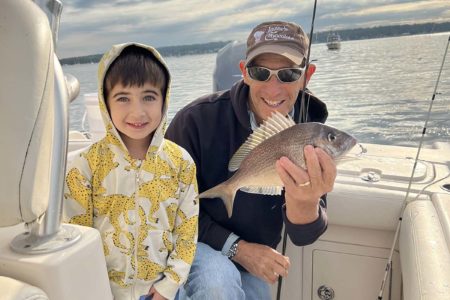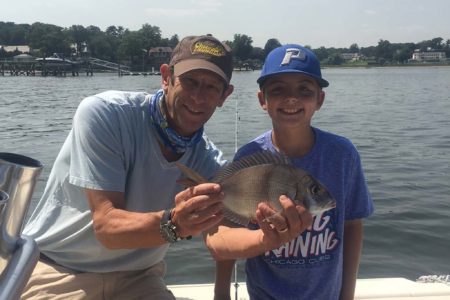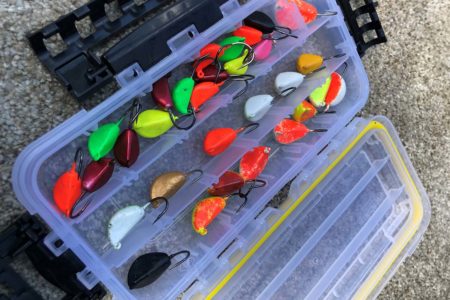A unique approach to catching big porgies without ever leaving the dock.
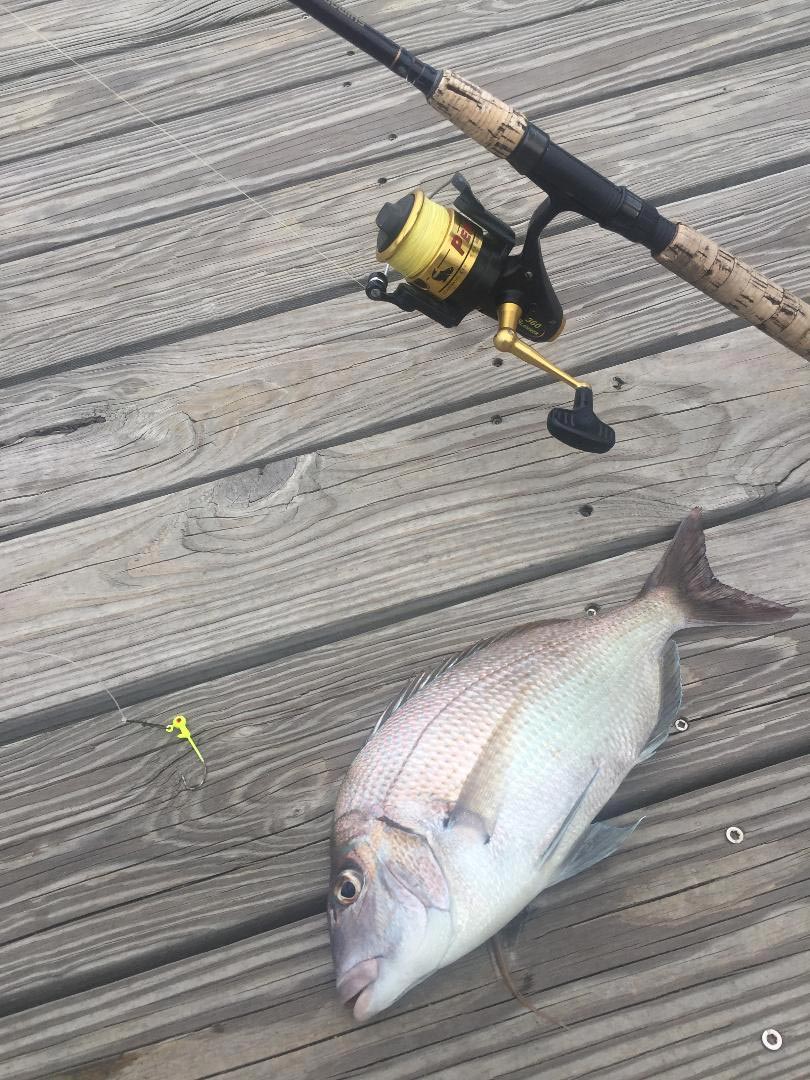
Porgies from a rocking chair? No, I have not lost my mind but I’ll bet that’s what you said to yourself when you saw the title of this article. Well, I’m happy to say that as of this point I have not yet lost my mind, although who knows what the future holds in store for me? Then too, family and friends have questioned my sanity for years. Sane or not, this article is the truth about my friend Rich Lazar, who during the summer of 2019 caught porgies from a rocking chair that rested on a shaded walkway above the docks of his marina in western Long Island Sound. The other part of this story is about fishing from his boat and never leaving the dock.
One summer day last season, Rich rose at dawn but couldn’t find anyone to go porgy fishing with him for various reasons. I was one of those who refused the invitation. Usually when this happens, Rich will take the boat out for an hour or so and fish some favored spots in the harbor casting for stripers. However, on this day it was hot and humid and he was very short on time, so he decided to cast a clam baited hook from the walkway in front of the marina’s office. So, he sat back in a rocking chair and talked to Dave who is an all-around good guy and dockmaster of the marina. Rich held no great expectations of success and was surprised when, after a while, the tip of his rod started jiggling. He picked it up, set the hook, and reeled in a porgy larger than the ones we had caught on the porgy grounds earlier in the week. He immediately sent me a photo with his phone and called me. At first, I didn’t understand what he was all excited about until I saw the pictures. Since then he has caught many big porgies and several white perch. Certainly, Rich had no idea that there were white perch in his harbor, and although I’m sure there aren’t huge schools of them, the fact that they live there at all was exciting to me because white perch is a species that spiced my fishing as a youngster in a creek off Peconic Bay. However, more to the point, how did Rich go about catching porgies from the comfort of a chair?
The How
For years the late John Richy of Terminal Tackle (now closed) would tell me about how he caught big porgies in only a few feet of water right up against the shoreline grass patches in Northport Harbor. Although I knew John was a straight shooter, my quiet reaction was yeah, sure. Because I doubted, I never tried it, and consequently never tested this approach and therefore never caught shallow scup. As Rich Lazar related the story of his rocking chair catch, I began to recall some of the things that John had said about how and when he fished for porgies against the shore. Sure enough, they matched up. First, since Long Island Sound tides can have a range of more than 9 feet, it’s a high tide proposition. For example, at Rich’s marina there’s only mud against the shore at low tide, and on extremely low tides he has to raise his engine almost out of the water to get out of or into the marina. Second, I now had evidence of such shallow water success from two harbors. One harbor could be unique, but two harbors suggests that the technique might produce in all North Shore harbors. They may not be concentrated on structure the way they are in the Sound, because frankly in many harbors there isn’t much structure other than a few boulders and docks. However, porgies are drawn into the harbors because of all the small young of the year baitfish that grow up there in summer. I imagine that when a school of porgies moves into a harbor they spread out and hunt baitfish.
Yes, I know, we use worms and clams for bait, but porgies are a lot more aggressive than many people believe. Years ago, in Peconic Bay we never used worms or clams, we used large squid strips that doubled as weakfish baits. I’ve also caught giant spawning porgies on small bucktails intended for school stripers, and caught any number of them on Bombers and other small swimming plugs at night while hunting for weakfish, stripers and blues. It’s clear that porgies are aggressive feeders and will chase small baitfish including sand eels, small peanut bunker, and spearing, and that they follow the incoming tide toward shore because the baitfish do the same seeking the marsh grass, boat docks, and anything else in the shallows that might provide some cover.
The Bite
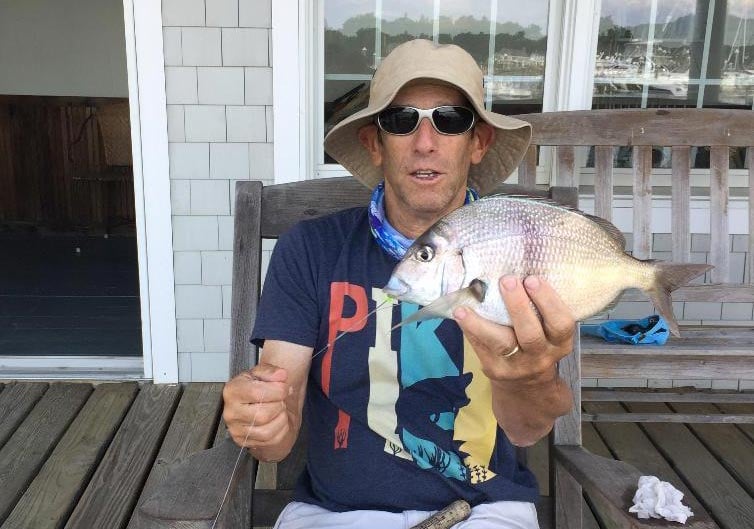
One of the things Rich noticed right away is the bite is never “hot.” The hits are few, soft, and subtle and it’s easy to pull the baited hook away from them unless you are patient: a lesson I didn’t cash in on. This is unlike fishing on structure in deeper water when we try to strike quickly and decisively at every hit before they steal the bait. However, schools feeding deep around structure will feed tightly together and competition is strong. Although driven into the shallows by a need for food, they are probably uneasy in very shallow water. Remember, porgies are essentially deep-water fish and winter on the continental shelf in about 50 to 55 fathoms.
Rich’s approach was the dead-stick method. He placed the rod on the porch as the clam baited hooks soaked in water close to the marsh grass. He watched the rod tip and talked to Dave. I guess you can see how this is labor-intensive fishing, yes? So, there’s Rich rocking back and forth, chatting with Dave, watching his rod tip twitch. At some point, and he won’t tell me how he knows the porgy has finally taken the clam in its mouth, he casually leans over, lifts the rod, sets the hook, and reels in a big porgy. Remember, the second part of this article is about catching fish from his boat in the marina, and as you’ll discover later, I had a hard time with this subtle pattern in both situations.
Okay, we have established that the best tide is around high water. However, it seems that the last hour or two of the incoming tide is better than the first hour or two of the out-going tide, perhaps because the porgies in some way sense the dropping tide and thus must leave sooner rather than later. The fishing lasts longer on days with extremely high tides, and will be poor between the moons when the tidal range is smaller. Time of day also seems to play a role in success or failure. Rich’s marina is on the western shoreline, and his best success occurred in the late afternoon when the sun lowered behind the trees and much of the water in the marina was shaded. Perhaps the shade combined with high water creates a sense of comfort. Cloudy days also seemed to improve the catch for similar reasons.
From a Moored Boat
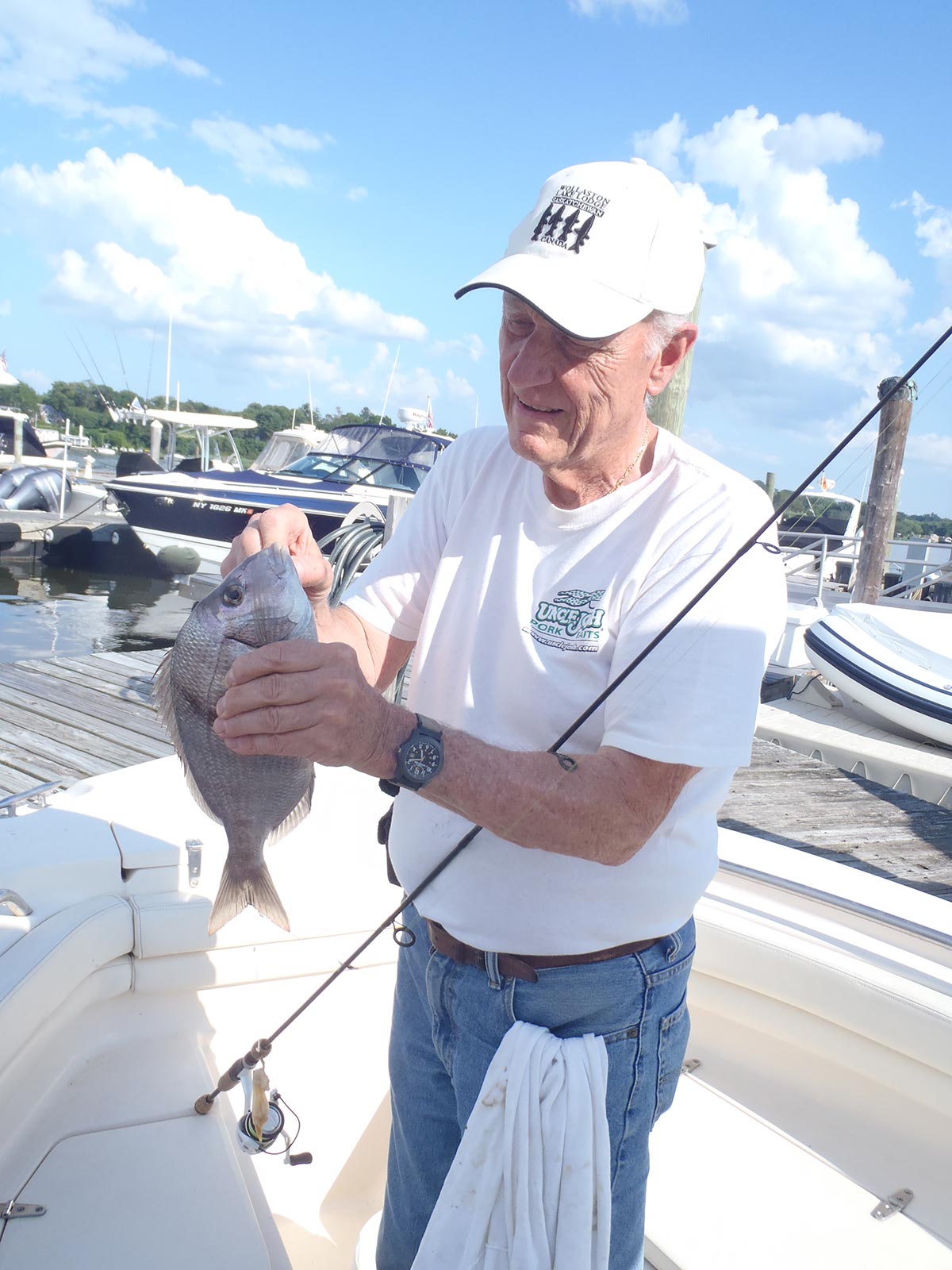
A few days after Rich’s first encounter with rocking chair porgies, we went porgy fishing in the conventional way. Although Rich was excited about fishing at the marina, we did not fish there because it was low tide when we left. However, after a so-so day on the porgy grounds that lacked both a hot bite and big porgies, we headed back to the marina an hour before high tide. We tied up and Rich told me to bait a hook and drop it right next to the boat. Doubting Thomas that I am, I threw him an expression of disbelief, but dutifully dropped the baited rig next to the boat. Although I have total trust in Rich’s fishing reports, catching big pork chops against the spartina grass or in a few feet of water next to his moored boat was a bit much.
He told me that we probably disturbed the porgies when we docked, but that they would remain under the docks and move on our baits in about 10 minutes. I waited without success. Even crabs left my bait alone. I guess Rich noticed my unenthusiastic body language and said one word, “patience.” At this point Rich’s friend Phil came along. Phil’s boat is tied up next to Rich with a 2- to 3-foot space between them. Phil had no intention of fishing, but Rich talked him into it. Rich gave him some clam bait, Phil climbed aboard his own boat, and dropped his rig in the space between the boats. The presence of an audience, Phil who I only know slightly, combined with my skepticism, evoked a barrage of sarcastic humor while Rich lowered a chum pot and began jigging it vigorously. Not a prize-winning comedy routine for sure, but it did pass some time.
At some point I thought I might have had a bite. If it was, it was so light and tentative that I would never call it a bite. Rich saw me strike and offered insight. “They bite very, very lightly at the dock or the grass line. Maybe it’s the shallows and maybe it’s something else but that’s what they do.” At this point, Phil who was attentively holding his rod and watching his rod tip, lifted his rod and pulled up a hefty porgy. Uh oh, what choice do I have now but to believe in this “rocking chair docked boat” scenario of porgy fishing? Still, it was only one fish. “Change your bait,” Rich suggested. “Hey, it’s only been down there a few minutes,” I said. “They want juicy, slimy clam baits, so change your bait,” Rich retorted. Rich chummed and Phil dropped another baited hook, and I changed my bait. Before I was baited, Phil wrested another big porgy from under his boat. Well, I thought, this is ridiculous! As high tide approached, Phil caught a few more porgies, Rich caught a few with a dead-stick approach while he chummed, and I may or may not have had a hit or two.
Eye Opening
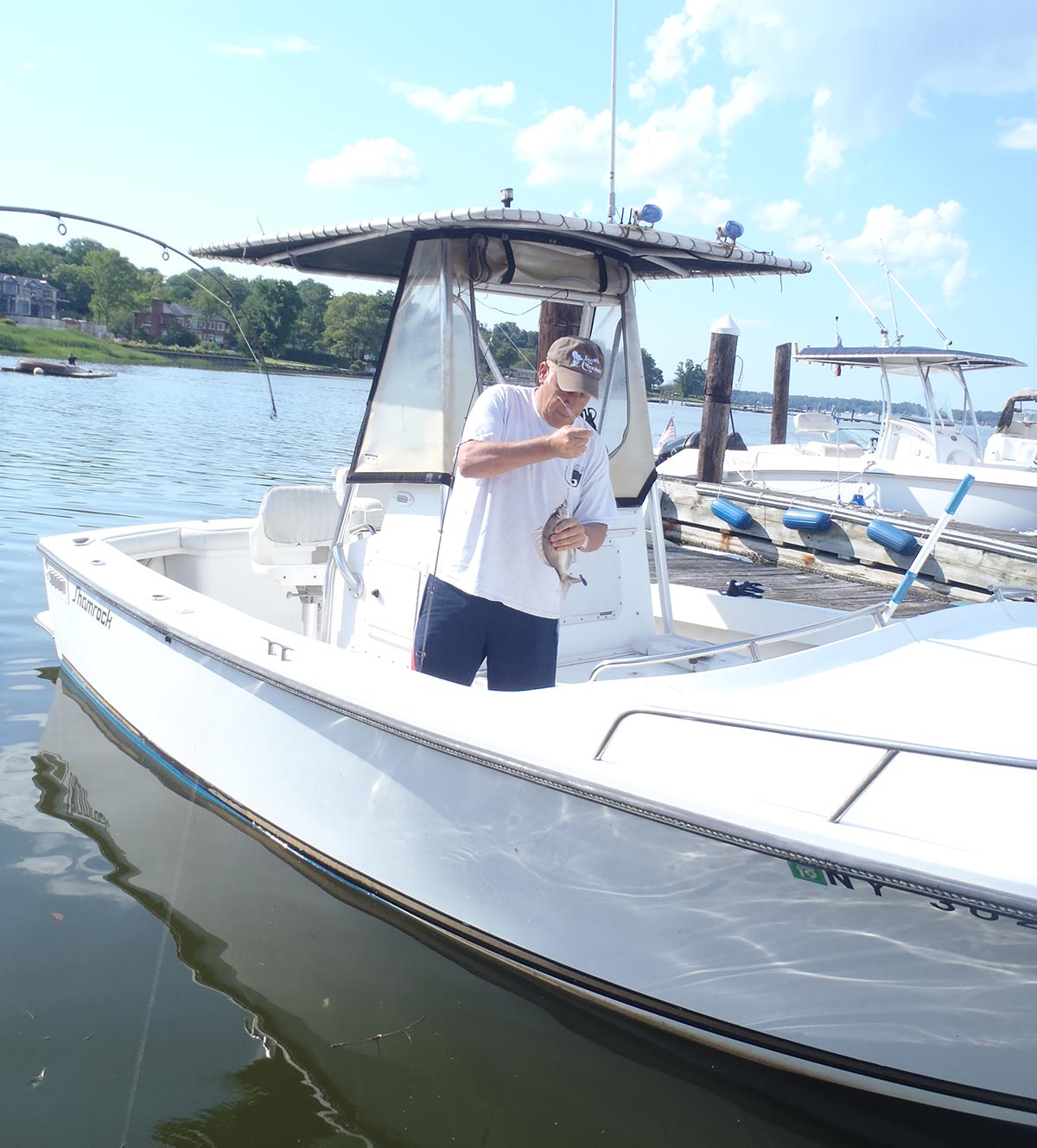
Although my productivity was zero, it was an eye-opening experience to say the least. Given the facts, I’m not sure that this is how I want to fish for porgies on a regular basis. First, I prefer my porgies a little more aggressive rather than guessing about the authenticity of bites. Second, it’s a short window lasting three-quarters of an hour to an hour-and-a-quarter at best. Third, the water is so shallow that the fight is over almost immediately after you set the hook. It’s fun, and a nice thing to do at the right tide while you clean your boat, but as a steady diet, well I’m not so sure about that.
However, there are a few interesting twists one might try that could spice the action. I was thinking of an approach using a micro rod and reel set up that’s probably better suited to bluegills than porgies. This could be a sporting challenge. Oh, one more thing. There is so much mud at the marina docks that Rich had to constantly lift and shake the chum pot in order to actually chum. Left undisturbed the pot sank below the mud’s surface. “Curiouser and curiouser,” as Lewis Carroll would say.

